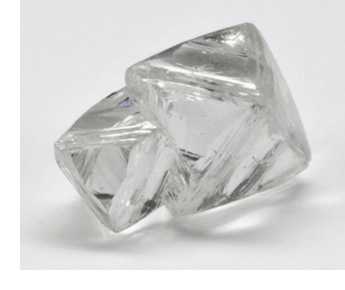Diamonds in the Rough
. . . Could Be a Rough Ride for Insurers!
Diamond rough—a chunk of unpolished, uncut stone, pretty much as it comes from the mine—used to be just the starting point for a piece of fine jewelry. Now it’s likely to be the centerpiece.
Nieman Marcus is showing it. Wall Street Journal is writing about it: Jewelry set with raw, uncut diamonds.
 What’s the attraction? A diamond’s cut—its expert faceting—is what gives the gem its sparkle and brilliance. Without that faceting, what’s the appeal?
What’s the attraction? A diamond’s cut—its expert faceting—is what gives the gem its sparkle and brilliance. Without that faceting, what’s the appeal?
Faceting is a relatively recent development, and even a taste for diamonds that sparkle is said to be only a few centuries old. Since ancient times maharajas, kings and queens have prized uncut diamonds for their natural beauty. Jewelry designers setting the trend today praise the elemental look and feel of such stones.
De Beers says its Talisman Collection, which mixes rough with faceted diamonds, “explores ancient beliefs about the power and magnetism of the uncut diamond.” This collection plays on the theme of ancient roots with names like Babylon Bracelet, Sun Medal Pendant, and Hypnotic Pavé Pendant. Other designers create elaborate custom designs for single rough stones.
One of the most famous rough diamonds is the Kahn Canary Diamond, worn by Hillary Clinton to both presidential inaugurations of her husband. The canary yellow diamond, owned by Stanley Kahn of Kahn’s Jewelers, was found at Crater of Diamonds State Park in Arkansas. It is said to have remained uncut in order to preserve its flawless natural beauty.
What about the 4Cs?
Jewelers, as well as buyers and insurers, rely on the 4Cs to grade a diamond’s quality and determine its value. How does diamond rough, used as a gem in jewelry, measure up?
Carat weight The Kahn diamond is 4.25 carats—large if it were a cut diamond. But rough diamonds used in jewelry sometimes weigh more than 250 carats.
Color For cut diamonds, the nearer the “color” is to colorless, the more valuable (except for the very rare deeply colored fancies). Rough diamond comes naturally colored in tones of white, yellow, brown, blue and pink.
Clarity Clarity is not totally determined until after the cutting and polishing procedure. A couple of years ago Diamond in the Rough offered an 89-carat rough diamond cocktail ring. The president of the design company said “It was a slate-gray and silvery stone. We didn’t touch it, except to wash the dirt off.” The price of the ring was $100,000.
Cut If you’re a regular reader of this newsletter, you know we emphasize that cut—the quality of the faceting—is responsible for as much as half the diamond’s value. Well....rough diamond has no cut.
Conclusion: the 4Cs do not apply. There is no external measure of the value of rough, no grading scales, no GIA certification. (Although buyers of diamond rough for the gem industry are trained to judge the general quality of rough, their expertise is not available to consumers or insurers.) For jewelry shoppers, rough’s beauty is in the eye of the beholder.
What about valuation?
From the manufacturer’s point of view, the price of rough diamond is far below that of cut diamond. The value of rough-diamond jewelry comes from the appeal of the raw stone, the design and craftsmanship of the piece, and the price the designer or retailer puts on it. It could be said that that’s the beauty of rough. Only experts like De Beers can really know the quality of the stone, so it’s not possible to comparison shop.
These days most such jewelry is high-end, but we can expect trend trickle-down. Trend watchers cite a general move toward natural forms and away from glitz.
The insurer’s best protection is a detailed descriptive appraisal, sales receipt, photograph, and documentation as to the designer or manufacturer.
What about scams?
Already scams have begun. Over the past year the diamond industry has been plagued by fake diamond rough. In one incident, con artists defrauded international diamond dealers by selling them colorless topaz as diamond rough. Some buyers were suspicious because the stones were always ice-cold when tested, they had unusual fractures, and the price was too low. Yet the crystals tested positive on the diamond tester. But on the cutting wheel, the bogus diamond rough shattered.
Earlier this year another scam involving “ingeniously designed rough diamond imitation” appeared in the trade. In this case gemologists said the substitute was probably phenakite, a mineral beryllium sillicate.
As yet there are no known instances of faux rough diamond at the retail level. However, if experts are taken in, needless to say the lay jewelry shopper would never be able to distinguish raw diamond crystals from any number of imitations.
If jewelry with rough diamond were scheduled and the customer later discovered the diamond was fake, he might be tempted to “lose” the jewelry. To minimize the possibility of overpaying in such a situation, the insurer should get, up front, as much documentation about the jewelry designer and manufacturer as possible.
FOR AGENTS & UNDERWRITERS
For jewelry with diamond rough, be sure to get a detailed descriptive appraisal, sales receipt, photograph, and any documentation as to the designer or manufacturer.
FOR ADJUSTERS
At this time, diamond rough is seen primarily in high-end jewelry sold in luxury jewelry outlets. The appraisal and documentation as to the designer and manufacturer, as well as the sales receipt, should guide you in determining the settlement.
©2000-2025, JCRS Inland Marine Solutions, Inc. All Rights Reserved. www.jcrs.com

